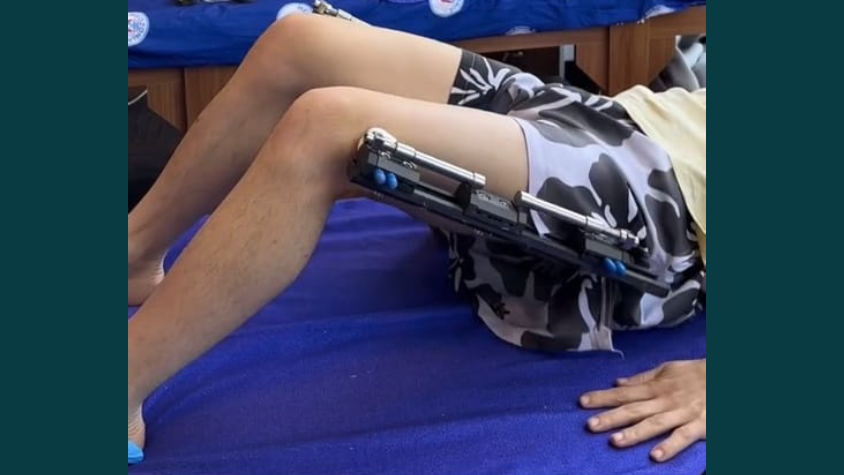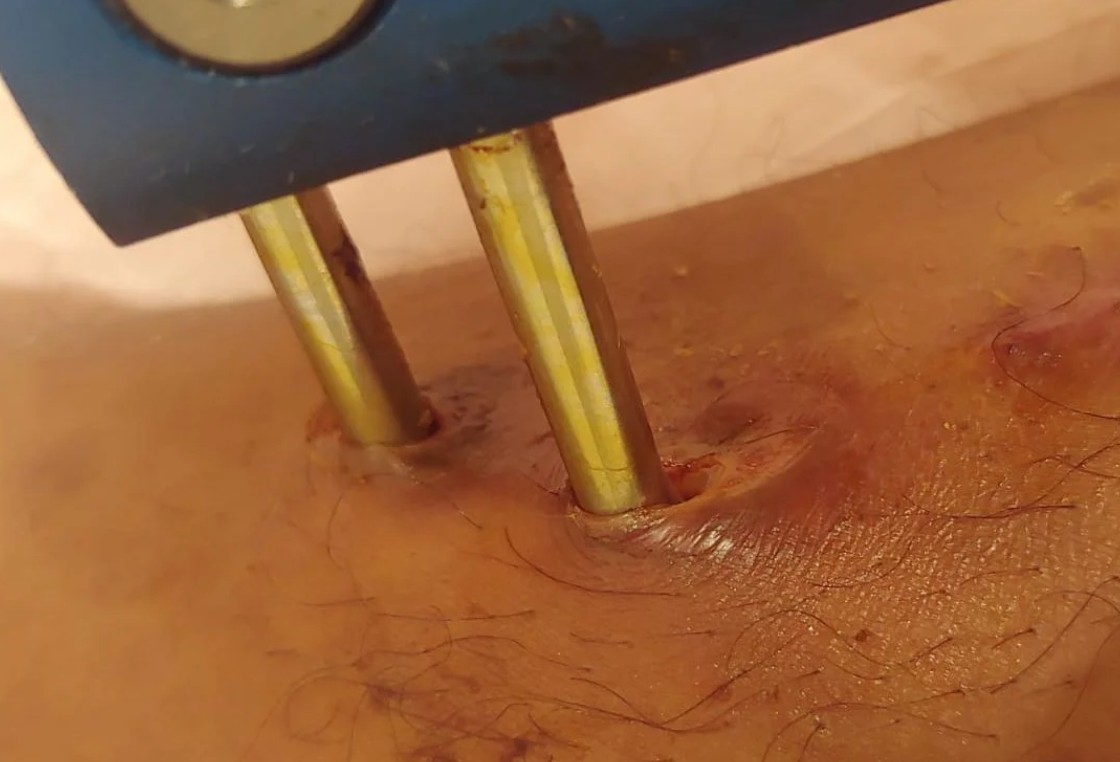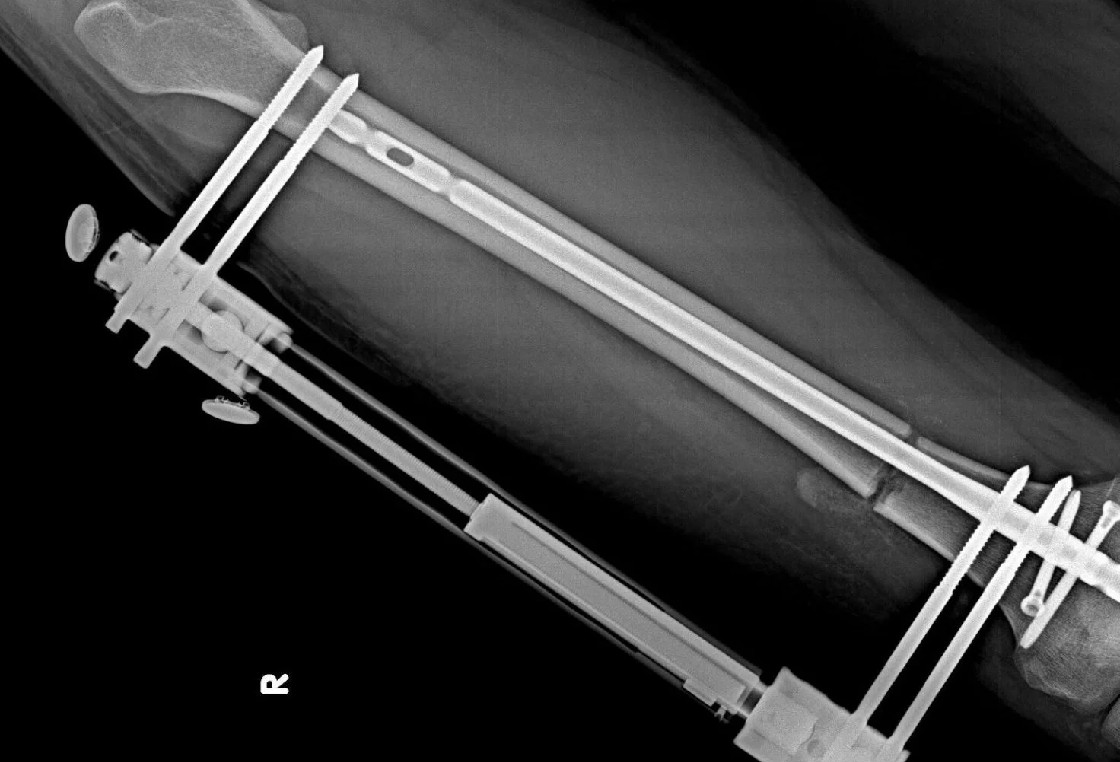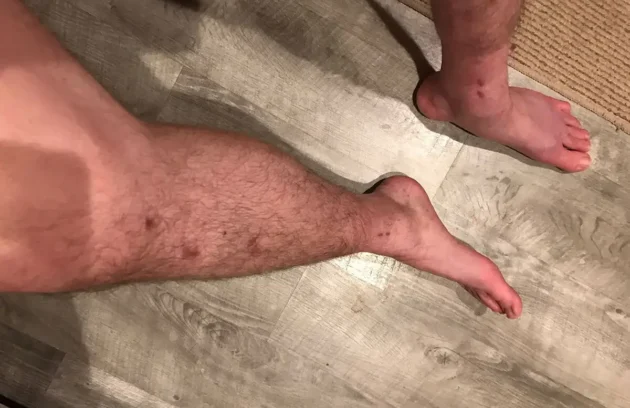The LON method, also known as the Combined method, is a modern technique that maximizes patient comfort and accelerates the recovery process. In this approach, specially designed nails are placed inside the bone during surgery, while external fixators are applied on the outside, ensuring that the process proceeds safely and in a controlled manner.
Unlike traditional techniques such as Ilizarov and Holyfix, external fixators in the LON method remain on the leg for only 2–3 months. This significantly reduces the risk of infection and allows patients to regain mobility much faster.
Its ease of application and cost-effectiveness make the LON method an ideal option for many patients. With this technique, patients not only get rid of the fixators more quickly but also adapt to their daily lives in a much shorter period of time.

Components of the LON method
External Fixators
The external fixator is a strong structure that provides external support to the bone during limb lengthening surgery. By keeping the bone stable, it helps ensure proper bone union throughout the lengthening process. The device is made up of thick metal rods and is attached to the bone with special pins, allowing the lengthening to be carried out safely and under control.
Placed during surgery, the external fixator typically remains on the leg for 2–3 months until the desired height is achieved. During this period, it not only maintains the balance of the bone but also supports the healthy progression of the lengthening process.

Intramedullar Nail
In limb lengthening surgeries, specially designed titanium nails are used as bone-compatible implants to support the bone and ensure the process is carried out safely. These nails are inserted into the bone canal during surgery, providing stability throughout the treatment.
The size of the nail is determined by the surgeon after reviewing X-ray images, with common sizes being 8.5 mm, 10.7 mm, 11.5 mm, and 12.5 mm.
Thanks to their biocompatible nature, titanium nails do not harm body tissues or cause negative reactions, making the recovery process safer and more reliable.

2 + 1 Surgeries with LON Method
Three surgeries will be done if the LON method is chosen for the limb lengthening;
The surgery is performed under general anesthesia, meaning the patient will be completely asleep and will not feel any pain during the operation. Before surgery, the doctor prepares a detailed plan based on the patient’s requirements and physical characteristics.
During the procedure, the leg bones (upper leg/femur or lower leg/tibia) are carefully cut at a predetermined point. This controlled cut creates the necessary space for the bone to lengthen later. For proper bone union and controlled lengthening, both an intramedullary nail and an external fixator are used during the operation.
Approximately 5 days after surgery, the lengthening process begins. Patients lengthen the bone by 1 mm per day by turning the screws with a special metal key. The screw is turned every 6 hours (0.25 mm x 4 = 1 mm/day).
Removal Surgery for External Fixator
Once the desired height is reached, the intramedullary nail inside the bone is secured with screws to preserve the new length. This procedure takes approximately 1–2 hours, and the patient remains in the hospital for one day under the doctor’s observation.
The intramedullary nail left inside the bone continues to provide support until the new bone fully matures and hardens, ensuring that the gained height remains permanent.
📹 Watch the video of our patient’s external fixator extraction after achieving their height goal.
After limb lengthening surgery, it generally takes about 12–15 months for the bones to fully consolidate and heal. At the end of this period, the intramedullary nail can be removed if the patient wishes.
The removal procedure lasts approximately 1.5–2 hours. After the operation, the patient stays under the doctor’s observation for a short period and is then discharged. To prevent the stitches from reopening, it is recommended to use crutches for 2–3 weeks.
Some patients may choose to keep the nail since it causes no health issues. Doctors also confirm that the nails are biocompatible and do not pose any harm.
📹 You can watch the video of intramedullary nail removal surgery performed at the request of our patient.
What Are the Advantages of the LON Method?
Quick Recovery: With the LON method, external fixators are removed after about 2–3 months. This early removal accelerates recovery and allows patients to regain strength in a shorter time.
Greater Lengthening: Since the device has a higher capacity compared to other methods, it is possible to achieve 9–10 cm of height gain, especially for younger patients.
Ability to Walk with Support: Throughout the process, patients can meet basic needs and cover short distances with supported walking. This provides a more comfortable recovery compared to staying immobile. While other methods often require patients to use a wheelchair for most of the lengthening period, the LON method offers freedom of movement.
Affordable Cost: The LON method presents a more economical limb lengthening option. The early removal of external fixators reduces overall costs, making it both a high-quality and cost-effective solution. This advantage makes it one of the most preferred methods among limb lengthening surgeries.
Controlled and Safe Lengthening: Since both the external fixator and intramedullary nail are used in the LON method, bones consolidate correctly and firmly. This dual support keeps the bone stable and minimizes the risk of improper union, ensuring a safe lengthening process.
Psychological Benefits: By allowing mobility and quicker recovery, the LON method also provides psychological relief. Being able to walk with support helps patients feel stronger and maintain motivation throughout the long healing journey.
What Are the Disadvantages of the LON Method?
Discomfort from External Fixators: In the LON method, external fixators remain on the legs for several months after surgery. This may cause discomfort for some patients. Fixators can lower sleep quality (due to the need to sleep in one position), restrict movements, and require extra care.
Risk of Infection: There is a risk of infection at the points where the fixators penetrate the skin and soft tissue. Not keeping these areas clean may increase the risk. To minimize this, a specialized treatment and care plan is implemented.
Aesthetic Concerns and Scarring: The use of external fixators may leave scars on the legs. Although these scars usually fade over time, they may still cause aesthetic concerns for some patients.
Psychological Effects: Living with fixators can be mentally challenging for some patients. The presence of fixators in daily life may cause discomfort and even depression during the process.
Shower Restrictions: Since wetting the fixators may increase the risk of infection, normal showers are not recommended during the lengthening phase. Showers can only be taken in a way that avoids wetting the surgical area.
Requirement of Expertise: The LON method requires advanced orthopedic expertise and cannot be performed by every orthopedic surgeon. Finding an experienced doctor may be challenging, and surgery performed by an underqualified surgeon could increase the risk of complications.
Why is the LON method often preferred by our patients?
Quick Recovery: With the LON method, external fixators remain in place for only 2–3 months, which accelerates the recovery process and enables patients to regain their strength in a shorter time. This also allows for an earlier return to work or activities such as sports.
Possibility of Supported Walking: During the lengthening process (2–3 months), patients can cover short distances by walking with support, making the overall process mentally easier.
Economical and Practical Solution: The LON method is considered an ideal option because it is affordable and easy to apply.
Psychological Comfort: The ability to walk with support and get rid of fixators in a relatively short time helps patients feel better and adapt more easily to the recovery process.
High Patient Satisfaction: Thanks to its many advantages and smoother recovery period, the LON method ensures a high level of patient satisfaction.
Because of the reasons listed above, about %80-85 of our patients choose the LON method.
Below, you can see the scars after limb lengthening surgery using the LON method. The healing speed of scars varies from person to person, but they will gradually fade over time.



The cost of limb lengthening surgery performed using the LON method typically ranges between $18,000 and $29,000. The variation depends on the scope of treatment and whether additional services such as accommodation and physiotherapy are included.
This price generally covers the following:
Surgery and a 4-day hospital stay,
Post-surgery care, including dressing changes and physiotherapy,
A second surgical procedure for the removal of external fixators,
Pre-operative accommodation,
Doctor’s consultation.
Since each patient’s treatment plan and recovery process may vary, an in-person consultation with the doctor is required to determine the exact cost.
Risk of Infection:
Infections may occur at the points where the external fixators contact the skin. This risk can be minimized with proper hygiene and regular dressing changes. If not detected and treated early, infection may lead to more serious health problems.Nonunion or Delayed Bone Healing:
In some cases, the bone may not heal at the expected rate or may not heal completely. Additional treatments such as bone grafting or stem cell therapy may be required.Nerve and Muscle Tension:
During the lengthening process, nerves and muscles may become tense, leading to nerve compression or muscle pain. In severe cases, additional procedures like tendon release surgery may be necessary.Bending or Fracture of the Nail:
The intramedullary nail may bend or break due to excessive load or improper movements. If this occurs, surgical intervention is usually required to correct the issue.Bone Deformity and Axial Deviation:
Misalignment or curvature of the bones may develop. In such cases, corrective surgeries may be necessary.
➡️ Although the likelihood of these complications with the Combined (LON) method is relatively low, the risks can be significantly minimized when the surgery is performed by an experienced surgeon and followed up with regular medical check-ups.
While the Precice method allows for a maximum lengthening of 8–8.5 cm, the LON method can achieve up to 9–10 cm. This is typically performed in the upper leg (femur).
However, the achievable amount of lengthening always depends on the doctor’s approval and the patient’s ability to meet the required conditions.
In limb lengthening surgery performed using the LON method, pain is usually most intense during the first few days after surgery. However, this pain is managed with appropriate pain relievers and medications, and it gradually decreases over time.
In the first weeks, pain is generally caused by bone healing and muscle stretching, and it may persist throughout the lengthening phase.
During the distraction phase, patients typically gain about 1 mm of height per day, which may cause mild to moderate tension and discomfort. Physiotherapy plays a vital role in reducing pain and improving mobility during this stage.
Pain usually decreases significantly after 4–6 weeks and becomes minimal once bone consolidation is completed.
In the LON method, external fixators are usually removed after 2–3 months. Once the devices are removed, your doctor will recommend that you gradually stop using support devices (walker, crutches) over a period of 4–6 weeks. The most important factor here is your X-ray results. If your bones are healing normally or well, this timeline may be shortened or extended accordingly.
Over the following weeks, your mobility will steadily improve, and you will gradually return to your daily life.
One of the most critical factors determining the recovery period is the amount of lengthening. The greater the lengthening (for example, every additional 1 cm), the longer the recovery process will be.
📹 You can watch the video of one of our patients at our center who achieved 11.5 cm of height increase with 2 limb lengthening surgeries.
